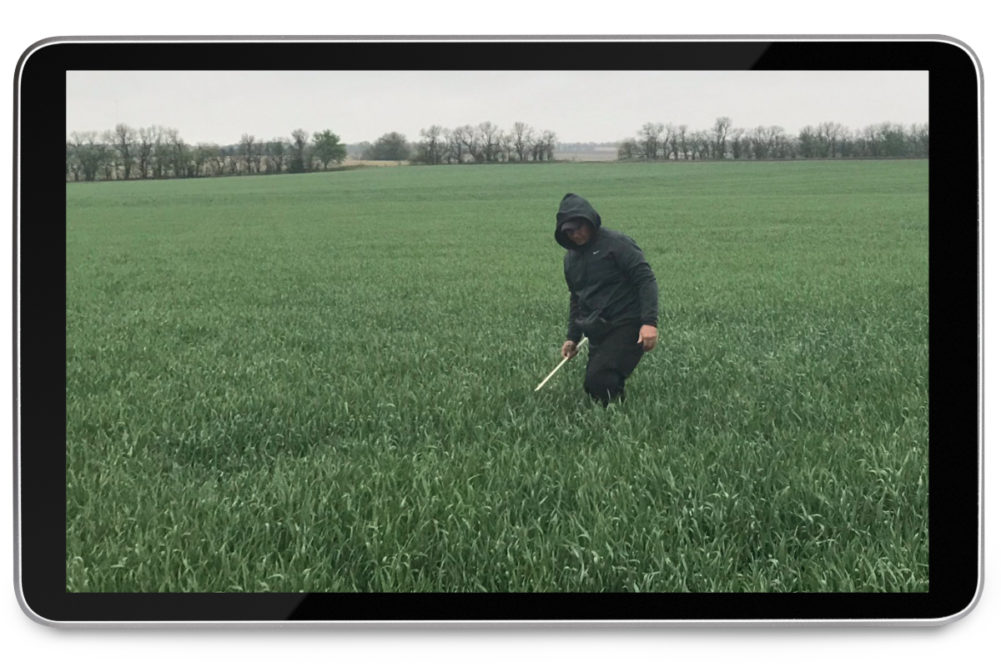MANHATTAN, KANSAS, US — More than 90 participants dialed into a Zoom meeting the afternoon of May 18 for the kick-off of the inaugural HRW Virtual Wheat Tour. Attendees were given an outline of the challenges the 2020 crop is facing and what freeze and disease pressures might be uncovered over the following three days.
The annual Wheat Quality Council Hard Winter Wheat Tour, a popular industry event for 50 years, was canceled March 31 as the coronavirus (COVID-19) pandemic continued to spread. The typical annual tour features teams of up to four wheat scouts rolling in dozens of rented SUVs and minivans traveling seven routes from Manhattan to Colby to Wichita and back to Manhattan, stopping in each county along the way to take a series of measurements and visual checks factored into a NASS-designed formula that resulted in an average bushels-per-acre estimate. The estimate is meant to be a snapshot at the time it is made, with the caveat that plenty could happen in the two months until the Southern Plains crops are harvested.
This year, Kansas Wheat asked local volunteers and experts to take measurements for use in this year’s NASS formula, which takes into account the number of tillers, or stalks, per foot, along with row spacing. This year, a late-season formula is likely to be employed in many places. That means scouts will be counting spikes and spikelets of the wheat head.
Volunteers include crop advisers, K-State Research and Extension personnel, representatives from the ag retail and grain handling industry, and leadership and staff of Kansas Wheat.
“This online tour is not an attempt to replicate what happens on the wheat tour,” said tour host Aaron Harries, vice president of research and operations with Kansas Wheat. “Our hope is that the in-person tour will resume in 2021. The goal of this tour is to provide a current snapshot of the Kansas wheat crop,” along with updates on the condition and progress of the Nebraska, Colorado and Oklahoma crops.
An update on the growth stage and conditions of the 2020 crop was issued by Romulo Lollato, wheat and forages extension specialist and an assistant professor at Kansas State University.
Lollato displayed a map showing areas of Kansas that fell short of normal precipitation levels after seeding and prior to the crop entering dormancy. The southwest corner of Kansas is believed to be the biggest area of concern. The lack of rain allowed that area to be seeded in a timely manner, but the continued lack of precipitation pushed emergence to sometime in January, reducing the yield potential of the crop.
Two freeze events, April 3 and April 13-17, affected the Kansas crop in various ways. Temperatures descended to 8 degrees on April 13.
“That’s extremely cold, and that’s part of the reason why we’re actually seeing some differences between the crop developments,” Lollato said, displaying a map showing counties in central and north-central Kansas experienced the highest risk based on the development of the crop on those dates and where temperatures fell the furthest.
Erick DeWolf of the department of plant pathology at K-State offered an update on wheat disease pressures expected in the 2020 crop.
Stripe rust, which takes its name from the rust-colored powdery spores on the plant leaves, is common in Kansas. Though rust grows systemically within the plant, it is unable to grow across the veins of the leaves, giving it the appearance of stripes. The disease has been active in parts of Kansas for several weeks, DeWolf said.
By May 1, the disease was reported on the lower leaves in some plants in a few Kansas counties in the south-central part of the state and a few others along the border with Oklahoma. Stripe rust appearances restricted to the lower canopy of the plants is less of a threat to yield as its appearance in the upper leaves. By May 15, stripe rust began appearing on lower canopies in counties in central and north-central Kansas, and was noted on upper leaves in five counties mostly near the center of the states.
Several wheat varieties previously thought to be resistant to stripe rust, including Larry, LCS Chrome, SY Monument and Zenda, began showing signs of susceptibility in 2019.
Beyond stripe rust, other disease pressure is possible, said Kelsey Anderson Onofre, wheat and forage extension specialist and assistant professor at Kansas State.
Septoria leaf blotch typically is noticed in the lower canopy and is signified by black fruiting bodies within the lesions on the leaves, she said. Like stripe rust, yield loss potential increases when septoria is noticed in the upper leaves of flag leaves.
Few leaf rust reports have been issued about the current crop, at least not severe outbreaks, Onofre said. This rust takes the form of dark orange lesions ranging from all over to one or two pustules and isn’t limited by the veins. Some yield loss can be expected when leaf rust is seen in the upper canopy.
Beyond these fungal diseases, viral diseases are possible, including wheat streak mosaic virus, which takes the form of yellow streaking, typically starting at the tip of the leaf.
Wheat streak mosaic “is actually vectored by a tiny mite who could pick this up from volunteer wheat near the field that has survived and moved it around in the field kind of like a mosquito might move malaria around,” Onofre said.
Fusarium head blight, also known as scab, can be especially problematic in eastern and central Kansas, she said. Unlike viral diseases, scab can only plague plants when they are flowering. The disease can be asymptomatic for several weeks until some bleaching of the head appears, then moving up or down. As scab can affect corn and soybeans, it can pressure fields used in crop rotations.
The HRW Virtual Wheat Tour will continue online May 19 with the first reports from scouts in the fields.






